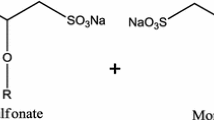Abstract
Dissolution of calcium salt of a long chain fatty acid or soap scum is a major challenge for hard surface cleaners since soap scum forms when soap is exposed to hard water and has very low water solubility. In this paper, the aqueous equilibrium solubility of calcium octadecanoate (or calcium stearate) was measured as a function of pH as well as chelating agent (ethylenediaminetetraacetate disodium salt) and surfactant concentrations. Anionic, nonionic, and amphoteric surfactants were studied. The highest soap scum solubility was observed at high pH with an amphoteric surfactant. Under this condition, the chelant effectively binds calcium, and the stearate anion forms mixed micelles well with the amphoteric surfactant, which is in zwitterionic form at high pH.




Similar content being viewed by others
References
Pandit NK, Strykowski JM (1989) Effect of pH and temperature on the solubility of a surface active carboxylic acid. J Pharm Sci 78:767–770
de Mul MNG, Davis HT, Evans DF, Bhave AV, Wagner JR (2000) Solution phase behavior and solid phase structure of long-chain sodium soap mixtures. Langmuir 16:8276–8284
National Organic Standards Board Technical Advisory Panel (TAP) Review, http://www.ams.usda.gov/nop/NationalList/TAPReviews/CalciumStearate2.pdf. [cited June 2007]
Kanicky JR, Shah DO (2003) Effects of premicellar aggregation on the pKa of fatty acid soap solutions. Langmuir 19:2034–2038
Sukhija PS, Palmquist DL (1990) Dissociation of calcium soaps of long-chain fatty acids in rumen fluid. J Dairy Sci 73:1784–1787
Bagby MO (1993) Carboxylic acids (survey). In: Kroschwitz JI, Howe-Grant M (eds) Kirk-Othmer Encyclopedia of Chemical Technology, vol 5. Wiley, New York, pp 77–88
Scamehorn JF, Harwell JH (2004) Precipitation of surfactant mixtures. In: Abe M, Scamehorn JF (eds) Mixed surfactant systems, 2nd edn. Marcel Dekker, New York, pp 601–655
Tai LHT (2000) Formulating detergents and personal care products a complete guide to product development. AOCS Press, Champaign
Martell AE, Motekaitis RJ (1992) Determination and use of stability constants, 2nd edn. VCH Publishers, Inc., New York
Stellner KL, Scamehorn JF (1989) Hardness tolerance of anionic surfactant solutions. I. Anionic surfactants with added monovalent electrolyte. Langmuir 5:70–77
Rathman JF, Christian SD (1990) Determination of surfactant activities in micellar solutions of dimethyldodecylamine oxide. Langmuir 6:391–395
Soontravanich S, Scamehorn JF, Harwell JH, Sabatini DA (2008) Interaction between an anionic and an amphoteric surfactant. Part I. monomer-Micelle equilibrium. J Surfact Deterg 11:251–261
Rodriguez CH, Chintanasathien C, Scamehorn JF, Saiwan C, Chavadej S (1998) Precipitation in solutions containing mixtures of synthetic anionic surfactant and soap. I. Effect of sodium octanoate on hardness tolerance of sodium dodecyl sulfate. J Surfact Deterg 1:321–328
Rosen MJ (2004) Surfactants and interfacial phenomena, 3rd edn. Wiley, New Jersey
Nakagaki M, Yokoyama S (1985) Acid-catalyzed hydrolysis of sodium dodecyl sulfate. J Pharm Sci 74:1047–1052
Motsavage VA, Kostenbauder HB (1963) The influence of the state of aggregation on the specific acid-catalyzed hydrolysis of sodium dodecyl sulfate. J Colloid Sci 18:603–615
Lunkenheimer K, Czichocki G (1993) On the stability of aqueous sodium dodecyl sulfate solutions. J Colloid Interface Sci 160:509–510
Acknowledgments
Financial support for this work was provided by the industrial sponsors of the Institute for Applied Surfactant Research at the University of Oklahoma, including Akzo Nobel, Clorox, Conoco/Phillips, Church and Dwight, Dow, Ecolab, Halliburton, Huntsman, Oxiteno, Procter & Gamble, Sasol, SC Johnson, and Shell. Dr. Scamehorn holds the Asahi Glass Chair in the School of Chemical, Biological and Materials Engineering at the University of Oklahoma. Dr. Sabatini holds the Sun Oil Company Chair in the School of Civil Engineering and Environmental Science at the University of Oklahoma.
Author information
Authors and Affiliations
Corresponding author
About this article
Cite this article
Soontravanich, S., Lopez, H.E., Scamehorn, J.F. et al. Dissolution Study of Salt of Long Chain Fatty Acids (Soap Scum) in Surfactant Solutions. Part I: Equilibrium Dissolution. J Surfact Deterg 13, 367–372 (2010). https://doi.org/10.1007/s11743-010-1208-5
Received:
Accepted:
Published:
Issue Date:
DOI: https://doi.org/10.1007/s11743-010-1208-5




